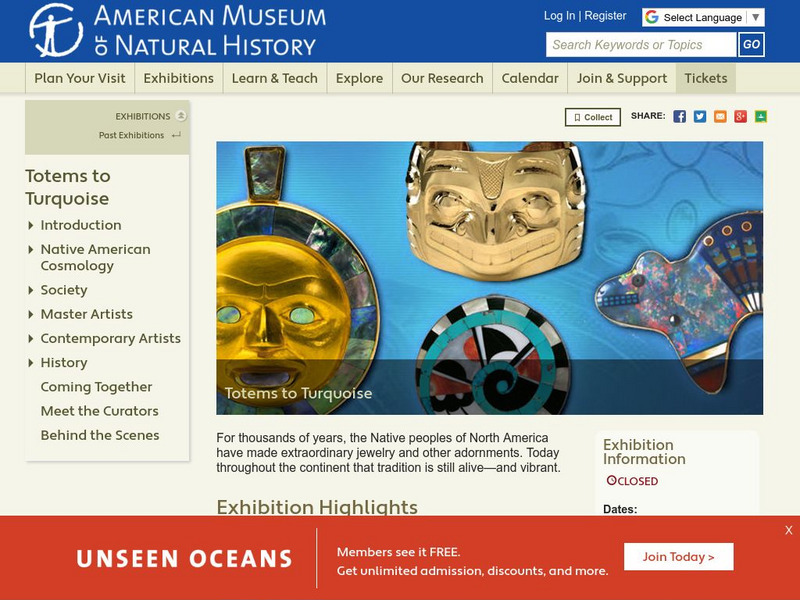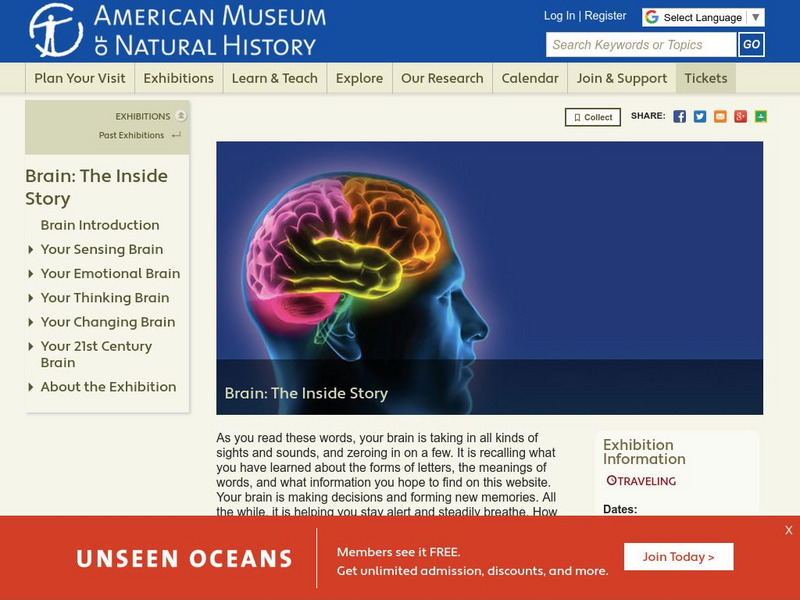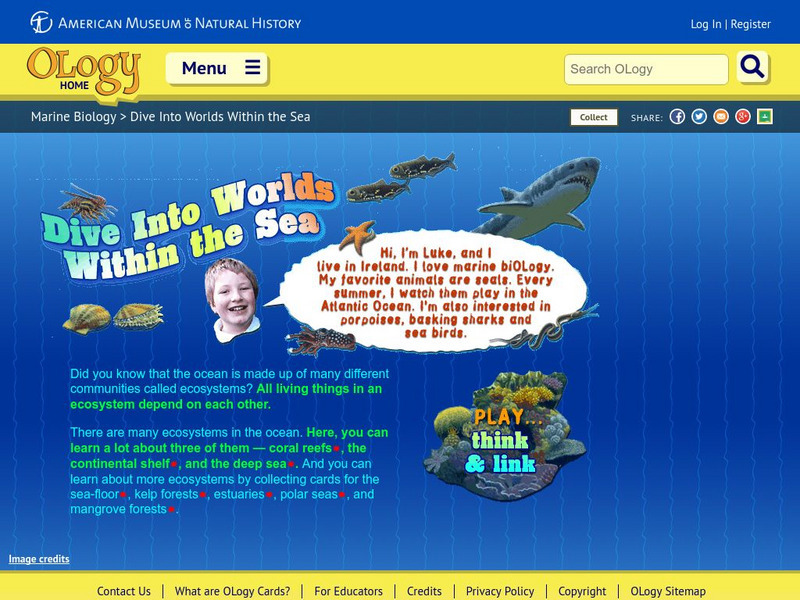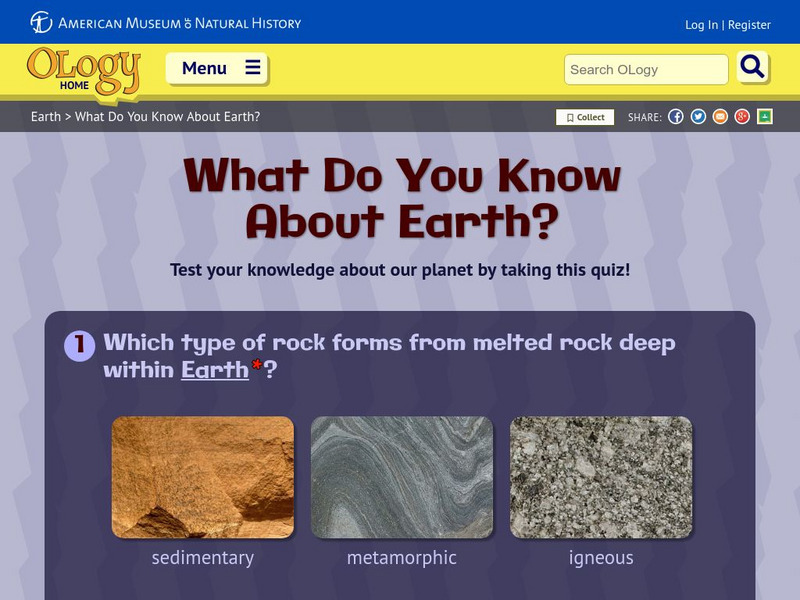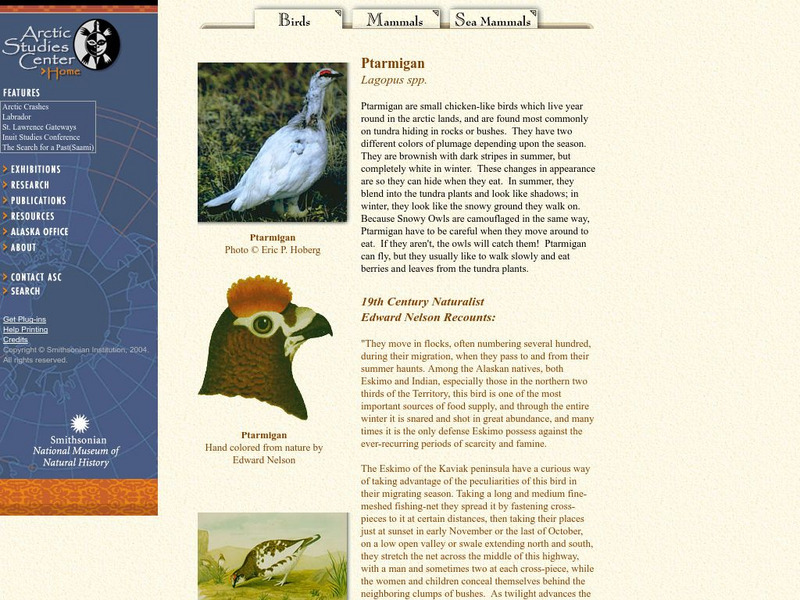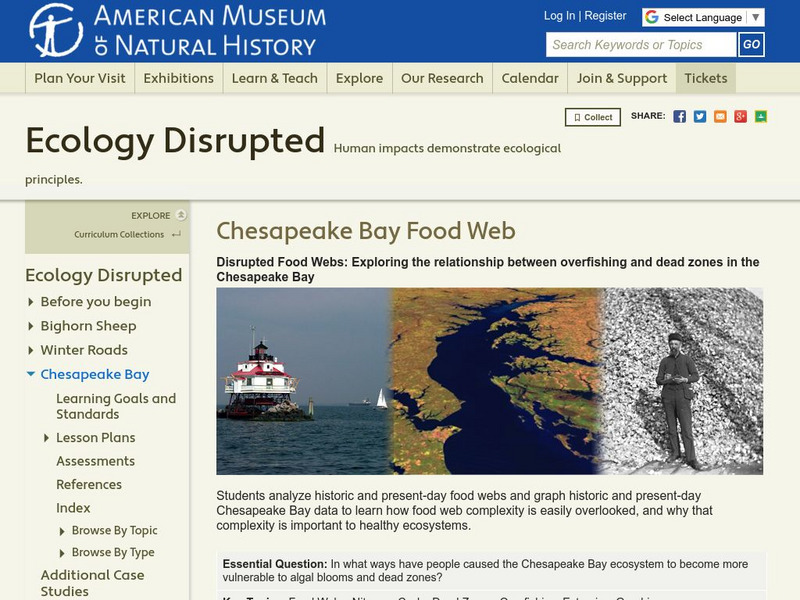American Museum of Natural History
American Museum of Natural History: Welcome to Dzanga Sangha
Connect the dots to investigate three different habitats either the forest, bai or river of the rain forest. By connecting the dots students make a food chain to see how organisms in each habitat depend on each other.
American Museum of Natural History
American Museum of Natural History: Find a Vent
Learn all about hydrothermal vents deep in the ocean and how scientists locate them. Then take a virtual expedition to the Juan de Fuca Ridge in the north Pacific and see if you can discover a new deep sea vent.
American Museum of Natural History
American Museum of Natural History: Totems to Turquoise: Native American Jewelry
Through this resource, the user can learn about the hand-crafted jewelry of Native North Americans of the Northwest and Southwest and how it embodies both the personal and collective identity of the maker and the wearer.
American Museum of Natural History
American Museum of Natural History: O Logy: Marine Biology: The Living Oceans
This resource is a place for exploring, asking questions, finding information, meeting scientists, and learning about marine ecosystems.
American Museum of Natural History
American Museum of Natural History: Race to the End of the Earth
Multimedia-rich exhibition documents the race, in 1911, to be the first to reach the South Pole. Two teams undertook the perilous journey, one British, led by Robert Scott, and one Norwegian, led by Roald Amundsen. With digital dioramas,...
American Museum of Natural History
American Museum of Natural History: Brain: The Inside Story
This exhibition documents how our brains sense, think, process emotions, and grow and change.
American Museum of Natural History
American Museum of Natural History: Dive Into Worlds Within the Sea
Think and Link to investigate three different ecosystem either the deep sea, coral reef or continental shelf. By connecting the dots students make a food chain to see how organisms in each habitat depend on each other.
American Museum of Natural History
American Museum of Natural History: Ology: Express Yourself
Test your skill at reading the emotion expressed in a face in these two matching games.
American Museum of Natural History
American Museum of Natural History: Ology: Paleontology: The Big Dig
A collection of online games, virtual puzzles, experiments, and interviews with experts to immerse students into the world of paleontology.
American Museum of Natural History
American Museum of Natural History: Paleont O Logy: The Big Dig
This colorful and inviting resource houses tons of paleontology activities to explore. Play the Layers of Time puzzle game, create your own make-believe dig site by burying chicken bones in plaster of Paris, learn how to draw dinosaurs,...
American Museum of Natural History
American Museum of Natural History: O Logy: What Do You Know? Earth Science
Take a ten question quiz on the Earth's surface.
Other
Santa Barbara Museum of Natural History: The Chumash People of California
A thorough look at the Chumash people of California. Read about their unique plank canoes, basketry, language, and cave paintings. Many pictures of artifacts and drawings accompany the information.
Smithsonian Institution
National Museum of Natural History: Ocean Portal, You Navigate
Delight in the fresh colors, sights, and sounds on this dynamic site on the ocean. Major categories consist of Ocean Life & Ecosystems, The Ocean Over Time, Ocean Science, and The Ocean and You. New information on sharks, a slideshow...
Smithsonian Institution
National Museum of Natural History: Ocean Portal: Ocean Life & Ecosystems
From the tiny to the titanic, from the familiar to the undiscovered, the ocean offers a stunning diversity of marine life and nearly every kind of habitat imaginable. Dive in and explore them here. Links incude stories, videos and photos...
University of Florida
Florida Museum of Natural History: Shark Basics
You will find the most commonly asked shark questions in this comprehensive site. Topics include shark basics, shark biology, shark conservation, shark attacks, and shark research.
University of Florida
Florida Museum of Natural History: Amphiprion Ocellaris: Clownfish Anemonefish
This comprehensive site provides an in-depth look at the clownfish along with colorful pictures and a helpful map showing where the fish live.
University of Florida
Florida Museum of Natural History: Sphyraena Barracuda: Great Barracuda
Very detailed information about the Great Barracuda. Get the taxonomy, common names, geographical distribution, habitat, features, food habits, reproduction, predators, importance to humans, and more.
Smithsonian Institution
National Museum of Natural History: Ptarmigan
This Smithsonian website has a brief, but thorough, article on the Ptarmigan. It also includes pictures and an extensive quote from 19th Century naturalist Edward Nelson.
Smithsonian Institution
National Museum of Natural History: Wildlife Portfolio
The Smithsonian Arctic Studies Center offers a portfolio of arctic animals. A page dedicated to each animal provides a physical description, personal observations of the animal in the wild, and several pictures.
American Museum of Natural History
American Museum of Natural History: Ecology Disrupted: Chesapeake Bay Food Web
In this comprehensive lesson unit, students examine how overfishing has affected Chesapeake Bay's ecosystem. They will study food webs from the past and present and graph related data.
American Museum of Natural History
American Museum of Natural History: Ology: Rising Co2! What Can We Do?
With this resource, students learn how much fossil fuel emissions have increased since 1600 by exploring a graph showing carbon dioxide in our atmosphere. Then answer questions and read facts about climate change over the centuries....
Smithsonian Institution
National Museum of Natural History: Lewis and Clark Mapping the West
Understand the importance of the mapping done by Lewis and Clark as you work through these learning exercises and learn mapmaking skills yourself.
Smithsonian Institution
National Museum of Natural History: Global Volcanism Program: This Dynamic Planet
Interactive activity that allows the learner to make their own regional map using layers of their choice such as volcanoes, craters, plate tectonics, or earthquakes. This map of the Earth zooms in and out, highlights essential processes,...
American Museum of Natural History
American Museum of Natural History: Make Your Own Mythic Mask or Puppet
Create your own masks and puppets and bring the mythic creatures to life.


